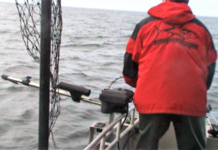
Currents are cohesive streams of seawater that circulate through the ocean. Some are short-lived and small, while others are vast flows that take centuries to complete a circuit of the globe. There are two distinct current systems in the ocean—surface circulation, which stirs a relatively thin upper layer of the sea, and deep circulation, which sweeps along the deep-sea floor.
Did You Know?
Each time a submersible goes down on an ocean exploration expedition, currents are an important consideration. If a submersible is tethered, such as a remotely operated vehicle (ROV), the current will tug at the ROV and the entire length of the tether. An autonomous submersible is not tethered, but may be forced by currents into a position from which it cannot free itself with relatively weak thrusters, endangering lives as well as equipment. Additionally, the surface currents may be very different than currents at depth, which can make launching and recovering submersibles an even greater challenge.
Surface currents are generated largely by wind. Their patterns are determined by wind direction, Coriolis forces from the Earth’s rotation, and the position of landforms that interact with the currents. Surface wind-driven currents generate upwelling currents in conjunction with landforms, creating deepwater currents.
Currents may also be generated by density differences in water masses caused by temperature and salinity variations. These currents move water masses through the deep ocean—taking nutrients, oxygen, and heat with them.
Occasional events also trigger serious currents. Huge storms move water masses. Underwater earthquakes may trigger devastating tsunamis. Both move masses of water inland when they reach shallow water and coastlines. Earthquakes may also trigger rapid downslope movement of water-saturated sediments, creating turbidity currents strong enough to snap submarine communication cables.
Bottom currents scour and sort sediments, thus affecting what kind of bottom develops in an area—hard or soft, fine grained or coarse. Bottom substrate (material) determines what kinds of communities may develop in an area.
Finally, when a current that is moving over a broad area is forced into a confined space, it may become very strong. On the ocean floor, water masses forced through narrow openings in a ridge system or flowing around a seamount may create currents that are far greater than in the surrounding water—affecting the distribution and abundance of organisms as well as the scientists and their equipment seeking to study them.
For More Information:
Ocean Currents, Multimedia Discovery Missions
Currents (pdf, 381 kb), Learning Ocean Science through Ocean Exploration: A Curriculum for Grades 6-12
Sign up for the Ocean Explorer E-mail Update List.














